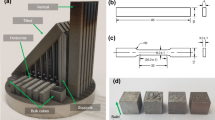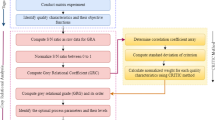Abstract
The selection of MgFeSi alloy and inoculants used for ductile iron treatment has confounded members of the foundry industry for many years. Frequently foundries have used certain types of alloys “because they have always done it that way” or “because someone else was doing it.” The current study involves ductile iron produced with three grades of MgFeSi with varying levels and types of rare earths along with four different inoculants. The iron was cast into test samples of various thickness from 2×2×8 inches to 10×10×8 inches. Mechanical properties and microstructures were evaluated at multiple locations in each of the 36 samples for a total of 156 points of data. In this paper, we will summarize the findings for differing section sizes.






















Similar content being viewed by others
References
A. Alagarsamy, S. Kumar, Demystifying shrinkage porosity in ductile iron castings. Inter Metalcast 14, 1136–1151 (2020). https://doi.org/10.1007/s40962-020-00440-3 (Figure 16)
Role of rare earth elements in production of ductile iron, Hot topics issue #5, 2007, Al Alagarsmy
A. Javaid, C.R. Loper Jr., Production of heavy-section ductile cast iron. Trans. Am. Foundrymen’s Soc. 103, 135–150 (1995)
Determine the relationship between solidification time and mechanical properties of heavy section ductile iron castings DIS project 23 by Arthur Spangler
T. Skalund, “A model for graphite formation in ductile iron,” PhD. Thesis, Metallurgisk Institutt Trondheim, 1992
D.H. Withey, C.R. Loper Jr., Effect of the use of chills in heavy-section ductile iron castings. AFS Transactions 77, 262–280 (1969)
L. Magnusson Aberg, “Trace elements and control limits in ductile iron,” Nov 13, 2014
P. Ferro, A. Fabrizi, R. Cervo, C. Carollo, Effect of inoculant containing rare earth metals and bismuth on microstructure and mechanical properties of heavy-section near-eutectic ductile iron castings. J. Mater. Process. Technol. 213(9), 1601–1608 (2013)
Acknowledgements
This paper would not be possible without the support from the authors’ respective companies. The MgFeSi and inoculant materials were supplied by Elkem and Carpenter Brothers Inc. The charge materials, production time and resources to cast the trial samples, as well as sample preparation and analysis, were supplied by the ownership/management at Betz Industries. This paper is an invited submission to IJMC selected from presentations at the 7th Keith Millis Symposium on Ductile Iron held October 18–20, 2023, at the Crown Plaza Atlanta Perimeter at Ravinia, Atlanta, GA. It is published in the IJMC by permission of the DIS (Ductile Iron Society).
Author information
Authors and Affiliations
Corresponding author
Additional information
Publisher's Note
Springer Nature remains neutral with regard to jurisdictional claims in published maps and institutional affiliations.
This paper is an invited submission to IJMC selected from presentations at the 7th Keith Millis Symposium on Ductile Iron held October 18-20,2023, at the Crown Plaza Atlanta Perimeter at Ravinia, Atlanta, GA. It is published in the IJMC by permission of the DIS (Ductile Iron Society).
Appendices
Appendix 1: ISO Standard section thickness mechanical properties
See Table 8.
Appendix 2 Chemistry results
Sample | MgFeSi | Inoculant | CE | C | Si | Mn | P | S | Cu | Cr | Mo | Ni | Mg | |
|---|---|---|---|---|---|---|---|---|---|---|---|---|---|---|
1 | 1 | 1 | 4.310 | 3.560 | 2.251 | 0.388 | 0.018 | 0.008 | 0.114 | 0.045 | 0.006 | 0.018 | 0.051 | |
2 | 1 | 2 | 4.355 | 3.580 | 2.326 | 0.413 | 0.024 | 0.008 | 0.100 | 0.036 | 0.003 | 0.014 | 0.044 | |
3 | 2 | 3 | 4.369 | 3.590 | 2.336 | 0.408 | 0.024 | 0.009 | 0.101 | 0.037 | 0.004 | 0.014 | 0.056 | |
4 | 1 | 4 | 4.344 | 3.590 | 2.263 | 0.406 | 0.015 | 0.009 | 0.110 | 0.056 | 0.006 | 0.019 | 0.041 | |
5 | 2 | 1 | 4.399 | 3.630 | 2.306 | 0.390 | 0.019 | 0.009 | 0.108 | 0.046 | 0.006 | 0.018 | 0.053 | |
6 | 2 | 2 | 4.302 | 3.550 | 2.255 | 0.413 | 0.021 | 0.007 | 0.105 | 0.044 | 0.004 | 0.016 | 0.049 | |
7 | 1 | 3 | 4.405 | 3.640 | 2.295 | 0.411 | 0.021 | 0.010 | 0.102 | 0.050 | 0.004 | 0.027 | 0.048 | |
8 | 2 | 4 | 4.393 | 3.620 | 2.320 | 0.405 | 0.014 | 0.011 | 0.099 | 0.065 | 0.006 | 0.028 | 0.039 | |
9 | 3 | 1 | 4.435 | 3.660 | 2.325 | 0.389 | 0.020 | 0.009 | 0.102 | 0.046 | 0.004 | 0.017 | 0.046 | |
10 | 3 | 2 | 4.350 | 3.590 | 2.279 | 0.399 | 0.017 | 0.009 | 0.099 | 0.054 | 0.004 | 0.035 | 0.041 | |
11 | 3 | 3 | 4.323 | 3.560 | 2.290 | 0.390 | 0.013 | 0.009 | 0.095 | 0.062 | 0.006 | 0.028 | 0.046 | |
12 | 3 | 4 | 4.387 | 3.620 | 2.300 | 0.383 | 0.015 | 0.004 | 0.098 | 0.041 | 0.003 | 0.016 | 0.059 | |
Median | 4.362 | 3.590 | 2.298 | 0.402 | 0.018 | 0.009 | 0.101 | 0.046 | 0.004 | 0.018 | 0.047 | |||
Std Dev | 0.0409 | 0.0348 | 0.0289 | 0.0111 | 0.0036 | 0.0017 | 0.0055 | 0.0092 | 0.0012 | 0.0068 | 0.0062 |
Al | Ti | Sn | Sb | Bi | Ce | V | Nb | Co | B | Zr | La |
|---|---|---|---|---|---|---|---|---|---|---|---|
0.024 | 0.008 | 0.012 | 0.006 | 0.0000 | 0.013 | 0.053 | 0.008 | 0.004 | 0.0000 | 0.000 | 0.0053 |
0.038 | 0.008 | 0.012 | 0.006 | 0.0009 | 0.014 | 0.045 | 0.007 | 0.004 | 0.0001 | 0.001 | 0.0048 |
0.021 | 0.006 | 0.012 | 0.007 | 0.0012 | 0.016 | 0.045 | 0.009 | 0.003 | 0.0001 | 0.001 | 0.0023 |
0.026 | 0.007 | 0.012 | 0.005 | 0.0012 | 0.014 | 0.045 | 0.007 | 0.004 | 0.0006 | 0.001 | 0.0053 |
0.021 | 0.008 | 0.012 | 0.006 | 0.0004 | 0.016 | 0.052 | 0.009 | 0.005 | 0.0001 | 0.001 | 0.0023 |
0.034 | 0.007 | 0.012 | 0.006 | 0.0008 | 0.016 | 0.046 | 0.006 | 0.004 | 0.0002 | 0.001 | 0.0025 |
0.019 | 0.006 | 0.012 | 0.005 | 0.0002 | 0.015 | 0.048 | 0.004 | 0.007 | 0.0005 | 0.000 | 0.0053 |
0.020 | 0.011 | 0.014 | 0.006 | 0.0006 | 0.015 | 0.045 | 0.010 | 0.003 | 0.0003 | 0.001 | 0.0016 |
0.020 | 0.005 | 0.012 | 0.005 | 0.0004 | 0.015 | 0.046 | 0.008 | 0.004 | 0.0002 | 0.001 | 0.0014 |
0.035 | 0.019 | 0.012 | 0.005 | 0.0001 | 0.016 | 0.059 | 0.006 | 0.013 | 0.0002 | 0.001 | 0.0013 |
0.026 | 0.010 | 0.014 | 0.006 | 0.0003 | 0.017 | 0.044 | 0.010 | 0.003 | 0.0002 | 0.001 | 0.0016 |
0.021 | 0.005 | 0.012 | 0.005 | 0.0017 | 0.018 | 0.046 | 0.007 | 0.004 | 0.0002 | 0.000 | 0.0027 |
0.022 | 0.008 | 0.012 | 0.006 | 0.001 | 0.015 | 0.046 | 0.008 | 0.004 | 0.000 | 0.001 | 0.002 |
0.0066 | 0.0039 | 0.0007 | 0.0004 | 0.0005 | 0.0014 | 0.0045 | 0.0016 | 0.0030 | 0.0002 | 0.0003 | 0.0016 |
Appendix 3: Alloy Additions
Sample | MgFeSi | Inoculant | Weight | Mg | Inoc | Mg Addition Rate (%) |
|---|---|---|---|---|---|---|
1 | 1 | 1 | 10000 | 135 | 50 | 1.35 |
2 | 1 | 2 | 10000 | 118 | 56 | 1.18 |
3 | 2 | 3 | 10000 | 129 | 50 | 1.29 |
4 | 1 | 4 | 10000 | 125 | 50 | 1.25 |
5 | 2 | 1 | 15000 | 195 | 75 | 1.30 |
6 | 2 | 2 | 24000 | 319 | 131 | 1.33 |
7 | 1 | 3 | 19000 | 296 | 59 | 1.56 |
8 | 2 | 4 | 25000 | 336 | 125 | 1.34 |
9 | 3 | 1 | 17000 | 219 | 79 | 1.29 |
10 | 3 | 2 | 11000 | 136 | 55 | 1.24 |
11 | 3 | 3 | 10000 | 136 | 50 | 1.36 |
12 | 3 | 4 | 17000 | 289 | 85 | 1.70 |
Rights and permissions
Springer Nature or its licensor (e.g. a society or other partner) holds exclusive rights to this article under a publishing agreement with the author(s) or other rightsholder(s); author self-archiving of the accepted manuscript version of this article is solely governed by the terms of such publishing agreement and applicable law.
About this article
Cite this article
Beach, T., Clayton, J., Leblang, P. et al. The Effects of MgFeSi and Inoculant Selection on Microstructure and Mechanical Properties of Varying Section Size Ductile Iron Castings. Inter Metalcast (2024). https://doi.org/10.1007/s40962-024-01265-0
Received:
Accepted:
Published:
DOI: https://doi.org/10.1007/s40962-024-01265-0




